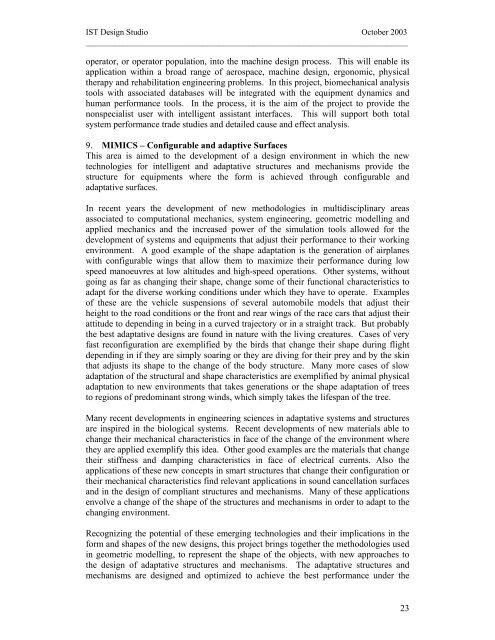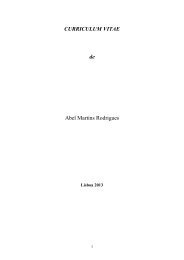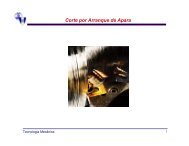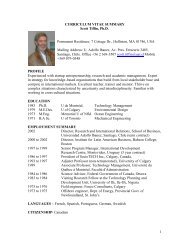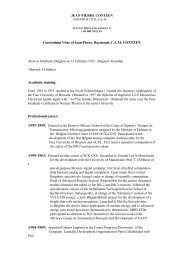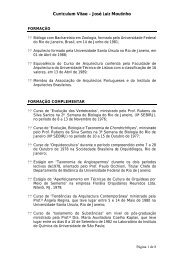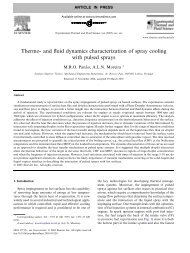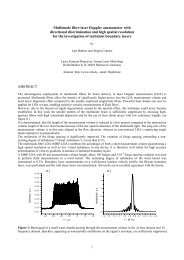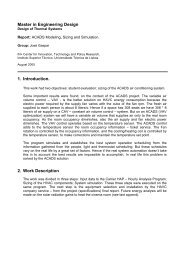THE IST DESIGN STUDIO: a plan for action⦠by Manuel ... - In+
THE IST DESIGN STUDIO: a plan for action⦠by Manuel ... - In+
THE IST DESIGN STUDIO: a plan for action⦠by Manuel ... - In+
Create successful ePaper yourself
Turn your PDF publications into a flip-book with our unique Google optimized e-Paper software.
<strong>IST</strong> Design Studio October 2003_____________________________________________________________________________operator, or operator population, into the machine design process. This will enable itsapplication within a broad range of aerospace, machine design, ergonomic, physicaltherapy and rehabilitation engineering problems. In this project, biomechanical analysistools with associated databases will be integrated with the equipment dynamics andhuman per<strong>for</strong>mance tools. In the process, it is the aim of the project to provide thenonspecialist user with intelligent assistant interfaces. This will support both totalsystem per<strong>for</strong>mance trade studies and detailed cause and effect analysis.9. MIMICS – Configurable and adaptive SurfacesThis area is aimed to the development of a design environment in which the newtechnologies <strong>for</strong> intelligent and adaptative structures and mechanisms provide thestructure <strong>for</strong> equipments where the <strong>for</strong>m is achieved through configurable andadaptative surfaces.In recent years the development of new methodologies in multidisciplinary areasassociated to computational mechanics, system engineering, geometric modelling andapplied mechanics and the increased power of the simulation tools allowed <strong>for</strong> thedevelopment of systems and equipments that adjust their per<strong>for</strong>mance to their workingenvironment. A good example of the shape adaptation is the generation of air<strong>plan</strong>eswith configurable wings that allow them to maximize their per<strong>for</strong>mance during lowspeed manoeuvres at low altitudes and high-speed operations. Other systems, withoutgoing as far as changing their shape, change some of their functional characteristics toadapt <strong>for</strong> the diverse working conditions under which they have to operate. Examplesof these are the vehicle suspensions of several automobile models that adjust theirheight to the road conditions or the front and rear wings of the race cars that adjust theirattitude to depending in being in a curved trajectory or in a straight track. But probablythe best adaptative designs are found in nature with the living creatures. Cases of veryfast reconfiguration are exemplified <strong>by</strong> the birds that change their shape during flightdepending in if they are simply soaring or they are diving <strong>for</strong> their prey and <strong>by</strong> the skinthat adjusts its shape to the change of the body structure. Many more cases of slowadaptation of the structural and shape characteristics are exemplified <strong>by</strong> animal physicaladaptation to new environments that takes generations or the shape adaptation of treesto regions of predominant strong winds, which simply takes the lifespan of the tree.Many recent developments in engineering sciences in adaptative systems and structuresare inspired in the biological systems. Recent developments of new materials able tochange their mechanical characteristics in face of the change of the environment wherethey are applied exemplify this idea. Other good examples are the materials that changetheir stiffness and damping characteristics in face of electrical currents. Also theapplications of these new concepts in smart structures that change their configuration ortheir mechanical characteristics find relevant applications in sound cancellation surfacesand in the design of compliant structures and mechanisms. Many of these applicationsenvolve a change of the shape of the structures and mechanisms in order to adapt to thechanging environment.Recognizing the potential of these emerging technologies and their implications in the<strong>for</strong>m and shapes of the new designs, this project brings together the methodologies usedin geometric modelling, to represent the shape of the objects, with new approaches tothe design of adaptative structures and mechanisms. The adaptative structures andmechanisms are designed and optimized to achieve the best per<strong>for</strong>mance under the23


